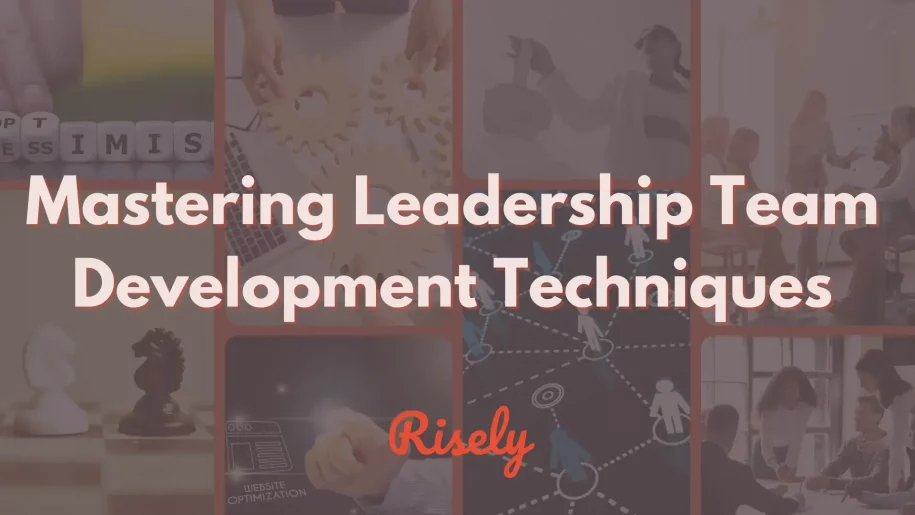Mastering Leadership Team Development Techniques
Leadership teams play a crucial role in the success of any organization. Comprising of senior leaders and executives, these teams act as the strategic think tank, setting and executing the organization’s strategy. However, building and developing effective leadership teams is not an easy task. It requires a deep understanding of team dynamics, competencies, and the ability to foster collaboration and communication among team members. In this blog, we will explore the techniques and strategies for mastering leadership team development.What is Leadership Team Development?
Leadership team development focuses on enhancing the effectiveness of senior leaders and executives within an organization. These individuals form the executive team, which is responsible for setting and executing the strategic vision of the organization. Leadership team development goes beyond individual leadership training and focuses on building a cohesive and high-performing team. It aims to develop competencies, foster collaboration and communication, and create a safe space for team members to grow and excel.How does it differ from leadership training?
Leadership team development is distinct from our typical leadership development and coaching programs. It stands out by focusing on shared development with a single objective that aligns heavily with your organization’s strategic vision. This strategic alignment is a key aspect that individual leadership development initiatives might overlook, as they tend to cater to personal needs. For L&D professionals, understanding and incorporating the organization’s core values and strategic objectives is crucial when designing development programs for managers and leaders.The Importance of Effective Leadership Teams in Organizations
Effective leadership teams are essential for the success of any organization. They bring together the expertise and experience of senior leaders to drive organizational goals and objectives. A well-functioning leadership team ensures that decisions are made collectively, with input from all team members, leading to better outcomes. An effective leadership team also fosters a culture of collaboration, accountability, and innovation within your organization. This, in turn, leads to increased employee engagement, improved performance, and overall organizational success.Core Components of Leadership Team Development
Leadership team development comprises several core components that contribute to the growth and effectiveness of the team. First and foremost, it involves the development of competencies required for effective leadership. You can achieve this through leadership training programs that enhance communication skills, strategic thinking, and decision-making abilities. Additionally, creating a safe space for team members to share ideas, provide feedback, and learn from each other is crucial for team development. This safe space encourages open and honest communication, fosters trust, and promotes collaboration among your team members. Third, leadership team development focuses on the development of all managers in a team along with shared ideas and objectives, thus impacting the leadership potential and outcomes of a specific organization heavily. It also presents a chance for leaders of different functions to come together on shared values and define interpretations for their particular functions.Why do leadership teams fail?
Leadership teams can fail for various reasons. One common reason is the presence of setbacks or challenges that hinder the team’s progress. These setbacks can include external factors, such as market changes, or internal factors, such as conflicts among team members. Another reason for failure is the lack of clarity within the team. If your team members are unclear about their roles, goals, or the organization’s strategy, it can lead to confusion and inefficiency. Additionally, misalignment among team members can also contribute to failure. When team members have different priorities or conflicting interests, it can disrupt their ability to work together effectively. Third, leadership teams can fail when they lack alignment and the ability to implement their plans. A leadership team development plan can help organizations tackle these critical challenges in three ways:- First, it brings together all your leaders on a common platform and reinforces the core ideals you operate on, thus building clarity and cohesion.
- Second, it improves upon the leadership skills of your organizational leaders.
- Third, it empowers the leaders to handle setbacks by training them in specific areas their roles need.
Key Techniques for Developing High-Performing Leadership Teams
Developing high-performing leadership teams requires the implementation of specific techniques and strategies.Establishing Clear Vision and Goals
Establishing a clear vision and goals is fundamental for developing high-performing leadership teams. A clear vision provides a shared understanding of the team’s purpose and direction, ensuring all team members are aligned toward a common goal. It clarifies your team’s strategic focus and helps guide decision-making and actions. By communicating the vision effectively, you can inspire and motivate team members, fostering a sense of purpose and commitment. Furthermore, clear goals break down your vision into actionable objectives, allowing the team to track progress and measure success.Fostering Effective Communication and Collaboration
Fostering effective communication and collaboration is vital for developing high-performing leadership teams. Strong communication skills ensure team members understand expectations, share information, and provide feedback. Here are some key strategies for fostering effective communication and collaboration within leadership teams:- Encourage open and honest communication
- Foster active listening skills
- Promote teamwork and collaboration
- Build strong professional relationships through trust and respect
Picking the right people for a leadership team
Selecting the right people for a leadership team is crucial for effectiveness and success. You need to identify individuals with the competencies and skills required for effective leadership. These competencies may include strategic thinking, decision-making, and strong communication skills. Additionally, considering the diversity of the team can bring different perspectives and strengths, enhancing team effectiveness. It is also important to assess individuals’ leadership potential and ability to work collaboratively in a team setting.Developing a competency framework and methods
Developing a competency framework is essential for the growth and development of leadership teams. A competency framework outlines the knowledge, skills, and behaviors required for effective leadership. It provides a clear roadmap for leadership development and helps identify areas for improvement. You can use leadership training programs and coaching to develop these competencies. Leadership training programs offer structured learning opportunities, while leadership coaching provides individualized support and guidance. By combining these methods, leadership teams can enhance their competencies and become more effective.Creating and applying a leadership team development plan
Creating a leadership team development plan is essential for guiding the growth and development of the team. This plan outlines the strategies, activities, and resources required to enhance team effectiveness and achieve organizational goals. It includes specific objectives, timelines, and measures of success. The development plan should consider aligning the team’s goals with the overall organizational strategy and involve relevant stakeholders. Here is an example of a leadership team development plan that you can try:| Objective | Activities | Timeline | Success Measures |
| Enhance communication | Conduct team-building workshops | Q1 and Q2 | Improved team collaboration and communication |
| Develop leadership | Provide leadership training programs | Throughout the year | Enhanced leadership competencies |
| Foster collaboration | Facilitate cross-functional projects | Ongoing | Increased collaboration and teamwork |
| Measure impact | Conduct team performance assessments | Annually | Improved team effectiveness |
Measuring the Impact of Learning and Development on Team Performance
Measuring the impact of learning and development programs on your team’s performance is crucial for assessing their effectiveness. You can do this through various methods, such as employee surveys, performance evaluations, and feedback from key stakeholders. Some key metrics to consider include team performance indicators, employee satisfaction levels, and the achievement of organizational goals. Additionally, conducting follow-up assessments and tracking team members’ progress can provide you valuable insights into the long-term impact of the programs. Regular measurement and evaluation allow continuous improvement and ensure that the learning and development initiatives align with your team’s goals and objectives.Conclusion
In conclusion, mastering leadership team development techniques is vital for organizational success. Effective leadership teams drive growth and innovation. Organizations can cultivate high-performing leadership teams by establishing a clear vision, fostering communication, selecting the right team members, and implementing continuous learning. Customized development plans and measurement of impact are key for continuous improvement. Remember, leadership teams play a crucial role in shaping an organization’s culture and performance. So, invest in their development to achieve long-term success and sustainable growth.Start building leadership skills at scale in your team.
Check out Risely’s AI led coaching for people managers with a free trial today.
Other Related Blogs
Building an Ultimate Leadership Development Action Plan
How to Build a Leadership Development Action Plan? Having a strong Leadership Development Action Plan is more critical than ever in today’s evolving business world. Whether you’re looking to drive…
Leadership Journey Examples on the RiseUp Radio Podcast
Leadership Journey Examples on the RiseUp Radio Podcast Leadership isn’t a destination – it’s a journey filled with twists, turns, and transformative moments that shape not just careers, but entire…
What is Immersive Learning? A New Era in Education
In this blog, you’ll learn what is immersive learning and how it is changing training, increasing engagement, and influencing the future of workforce development. … Read More
What are Learning Designs? All You Need To Know
This blog explains what learning designs are in depth while also covering it’s key components. It tells you about the process involved in creating a good learning design along with…


